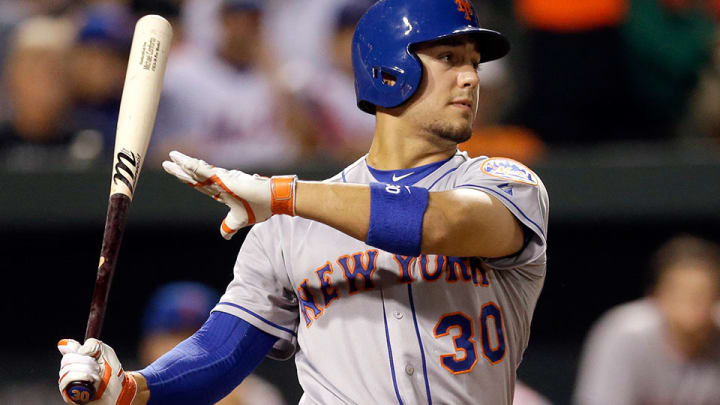Yoenis Cespedes has lifted Mets, but he's not alone in carrying them

The Mets’ offense has been entirely transformed in the six weeks since the sweet-swinging outfielder came east to New York. Through July 31, it was punchless, ranking last in the majors in both runs (3.5 per game); the club was 53–50 and two games behind the Nationals in the NL East thanks to its pitching alone. Since the calendar flipped to August, though, the Mets have scored 6.1 runs per game, a rate that has not only been the league’s best—exceeding even the scorching Blue Jays—but one that is comparable with those of the most potent lineups in recent history, like the 1999 Indians of Manny Ramirez and Jim Thome (6.23) and the '96 Mariners of Ken Griffey Jr. and Alex Rodriguez (6.17). The Mets are now 83–62, with an 8 1/2-game NL East lead, and their odds of winning the division are as much of a lock as can be before the key has been turned: 99.9%, according to Baseball Prospectus.
Wait 'Til Next Year: Phillies finally tear it down in 2015 to rebuild for future
Yoenis Cespedes? He has been sensational since being acquired from Detroit, the platonic ideal of a trade deadline boost. In his 41 games with New York, the 29-year-old Cuban has batted .309 with 17 homers and 42 RBIs, captivating the city like no athlete since Jeremy Lin in 2012. The outfielder in question, though, is the 22-year-old rookie Michael Conforto, who plays leftfield to Cespedes’s center. Since he was promoted from Triple A Las Vegas on July 24, Conforto, New York’s first-round pick in 2014, has an OPS of .925, which ranks him 12th in the league overall among players who have as many or more plate appearances than he does (148).
• CORCORAN: Cespedes is great, but Harper is no-doubt NL MVP
Cespedes’s nightly heroics have dominated highlight reels and the imaginations of the residents of his new city, and rightly so. But he has not turned around the Mets’ season on his own, and he has had more running mates than just Conforto. Consider this: Through the end of July, the club’s cumulative OPS was .662, baseball’s worst, and it had just three players who had made at least 85 plate appearances and had produced an OPS in excess of .700: Lucas Duda, Curtis Granderson and Daniel Murphy. Since Aug. 1, the Mets’ team OPS is a league-best .840, and the minimum OPS among its top 13 most frequently used batters is .706.
Wait 'Til Next Year: For awful Braves, is even worse to come in 2016?
Of course, while the uniforms are the same, the players who now fill them are, to a significant degree, different. In July, the Mets’ top 11 plate appearance leaders included names like Juan Lagares, Kevin Plawecki, Kirk Nieuwenhuis, Eric Campbell, Michael Cuddyer and John Mayberry Jr.. Since Aug. 1, that uninspiring sextet has been replaced not only by Cespedes and Conforto, but also by Kelly Johnson and Juan Uribe, who were both acquired from Atlanta, and by Travis d'Arnaud and David Wright, who have both recovered from long-term injuries; all six represent significant upgrades. These are no longer the same old Mets, either in performance or constitution.
It was only on July 29 when Sandy Alderson’s five-year tenure as the Mets’ general manager seemed to have reached its nadir, when Wilmer Flores was left to weep at shortstop after hearing he had been traded, along with injured starter Zack Wheeler, in exchange for Brewers centerfielder Carlos Gomez. When that deal fell through shortly thereafter, Alderson was blasted for not only seeming to have embarrassed one of his own players, but also for having done so for no reason. The 67-year-old GM, though, is generally imperturbable—at least when Scott Boras is not involved—and he has avoided making decisions in response to tabloid headlines, a job requirement in New York.
• CORCORAN: Nationals' Williams among managers feeling heat
How the Mets and Cubs became MLB playoff contenders again
The Cespedes deal came two days later, and it proved beyond reproach, especially now that Gomez has batted just .234 with four home runs and 13 RBIs since he was subsequently traded to the Astros, and is currently injured. Alderson’s deal for Uribe and Johnson has also proven crucial, as has his patience in waiting for d'Arnaud and Wright to return from a sprained elbow and spinal stenosis, respectively. The former, in particular, has been a revelation; among catchers, his OPS of .929 is more than 50 points better than the second-ranked Buster Posey’s, albeit in a much smaller sample size.
When the Mets reach their first postseason in nine years, the central storyline will revolve around Cespedes, as it should. Mets fans have been desperate for a savior for years, and he fits the bill. In reality, though, the reasons for the club’s success are more widespread, and longer in the making. The many players who have ably supported Cespedes should not go without credit, and neither should the man who has, through both tinkering and patience, overseen the most stunning offensive turnaround in recent baseball memory. Alderson has always believed in what he was doing, and now New York must believe in it, too.
